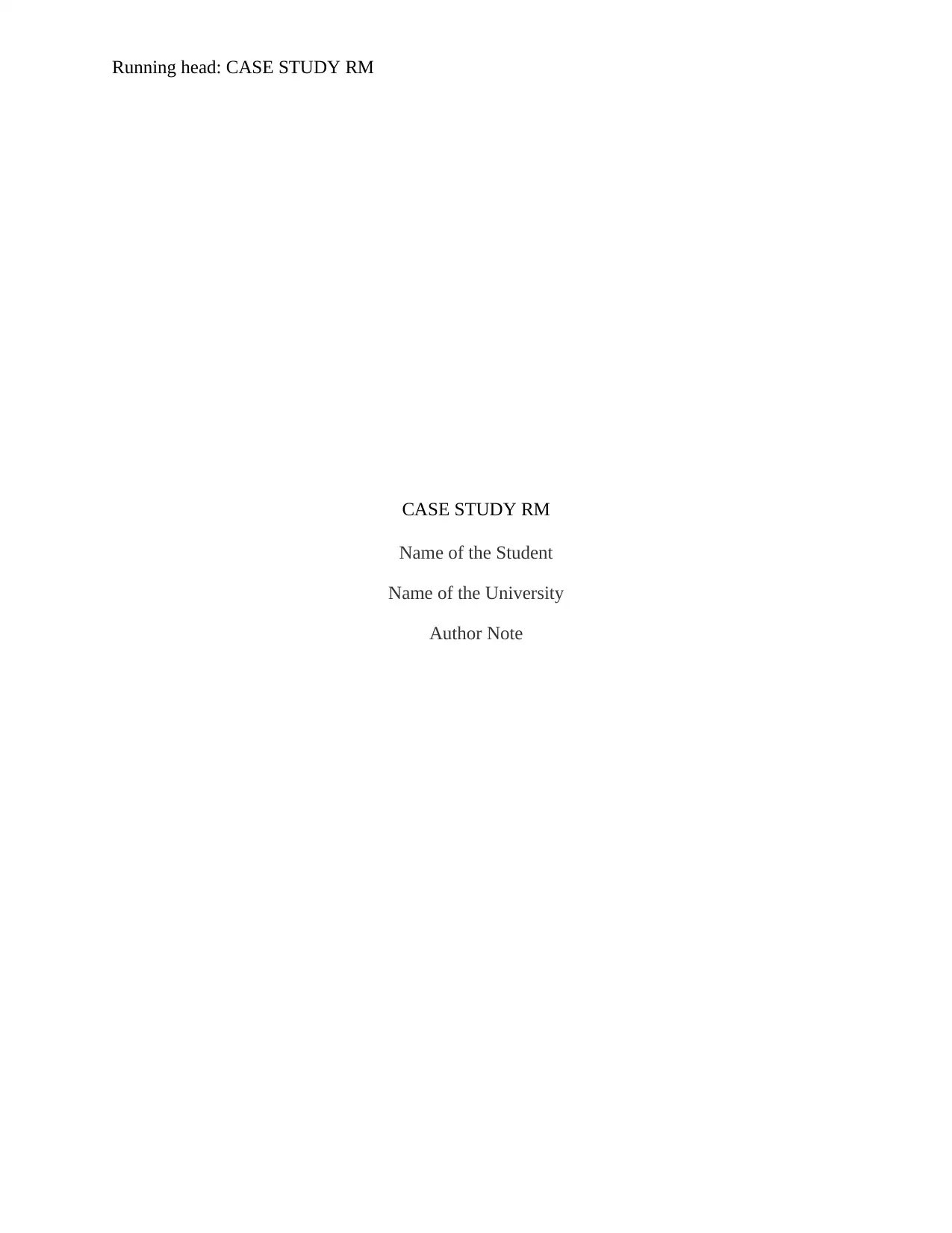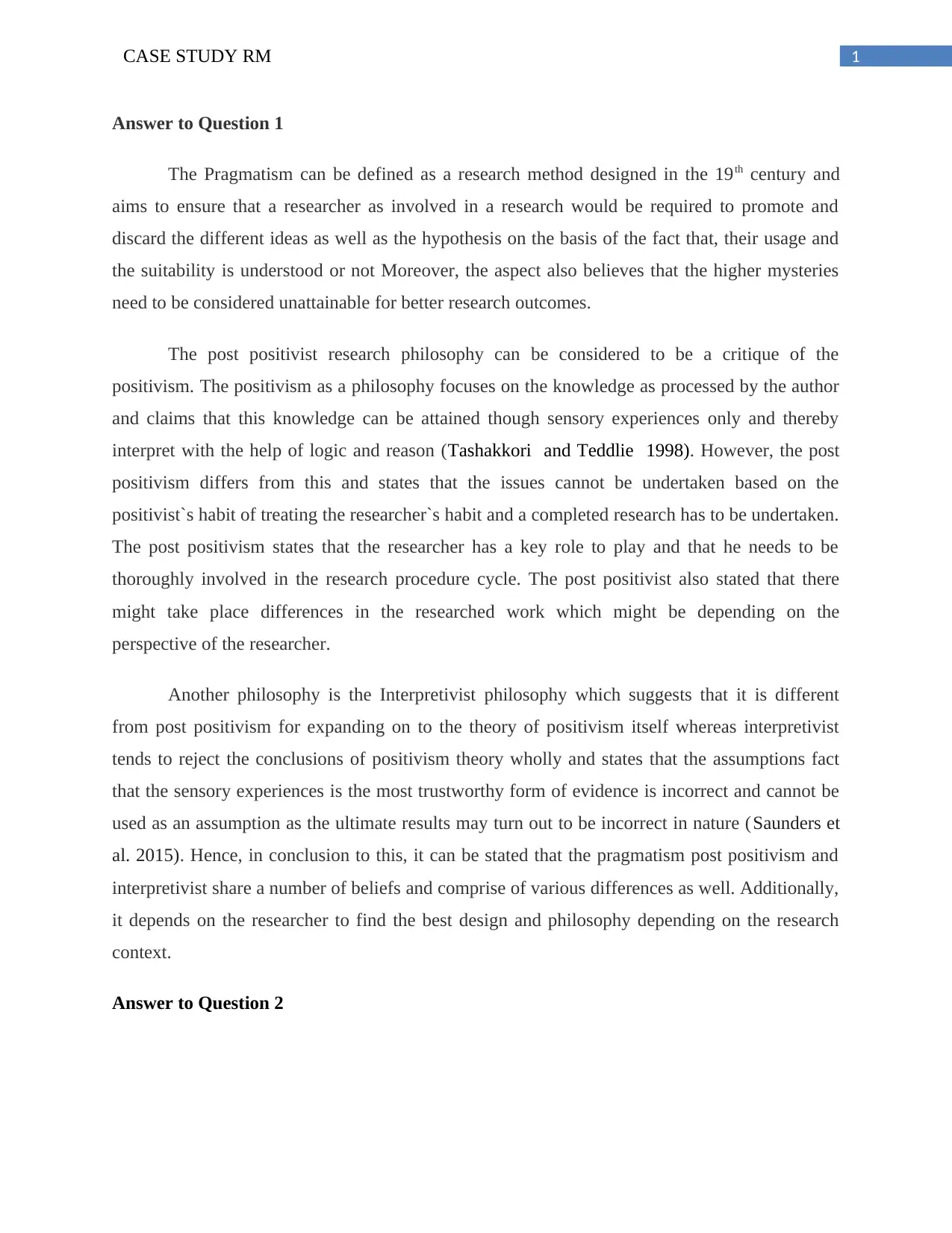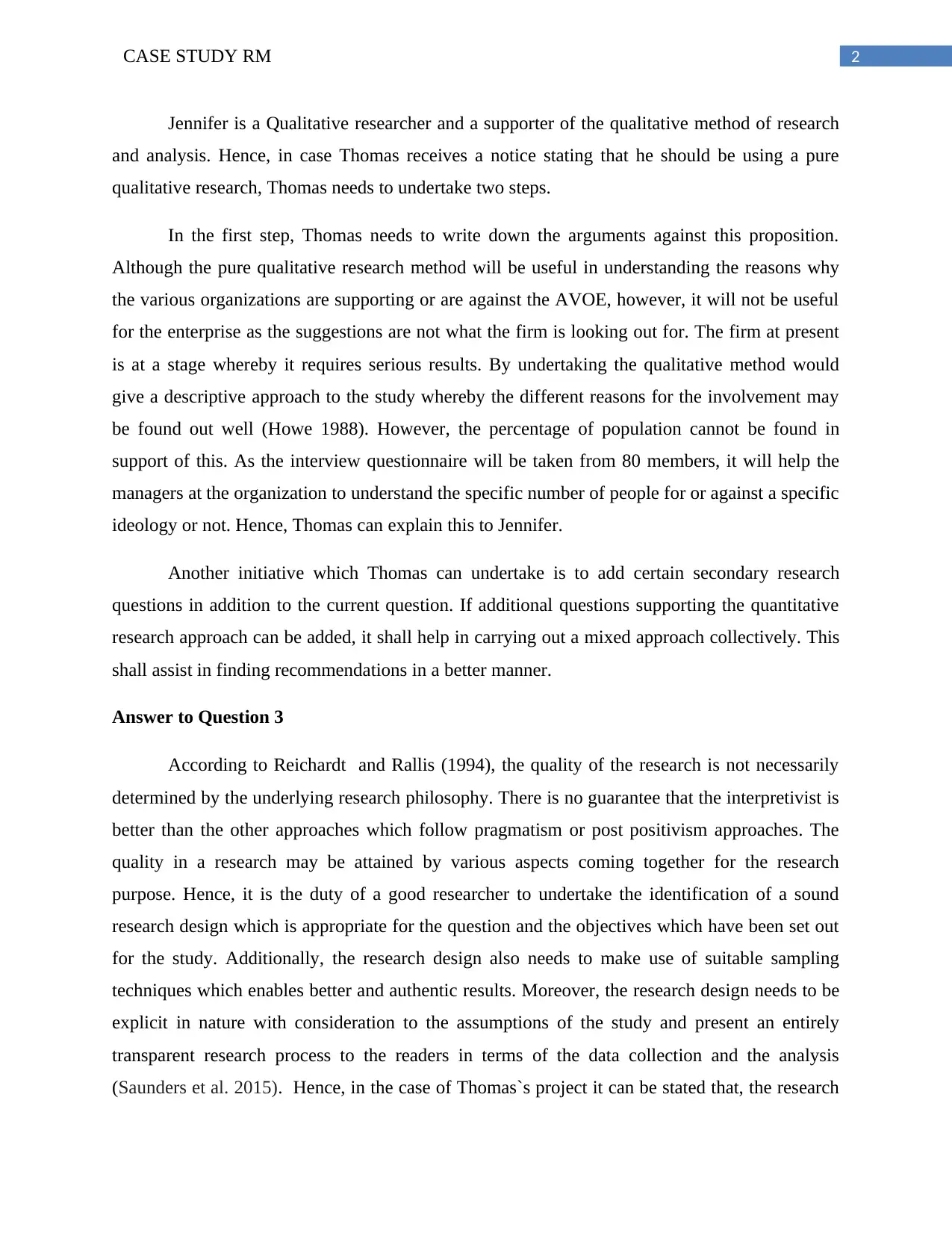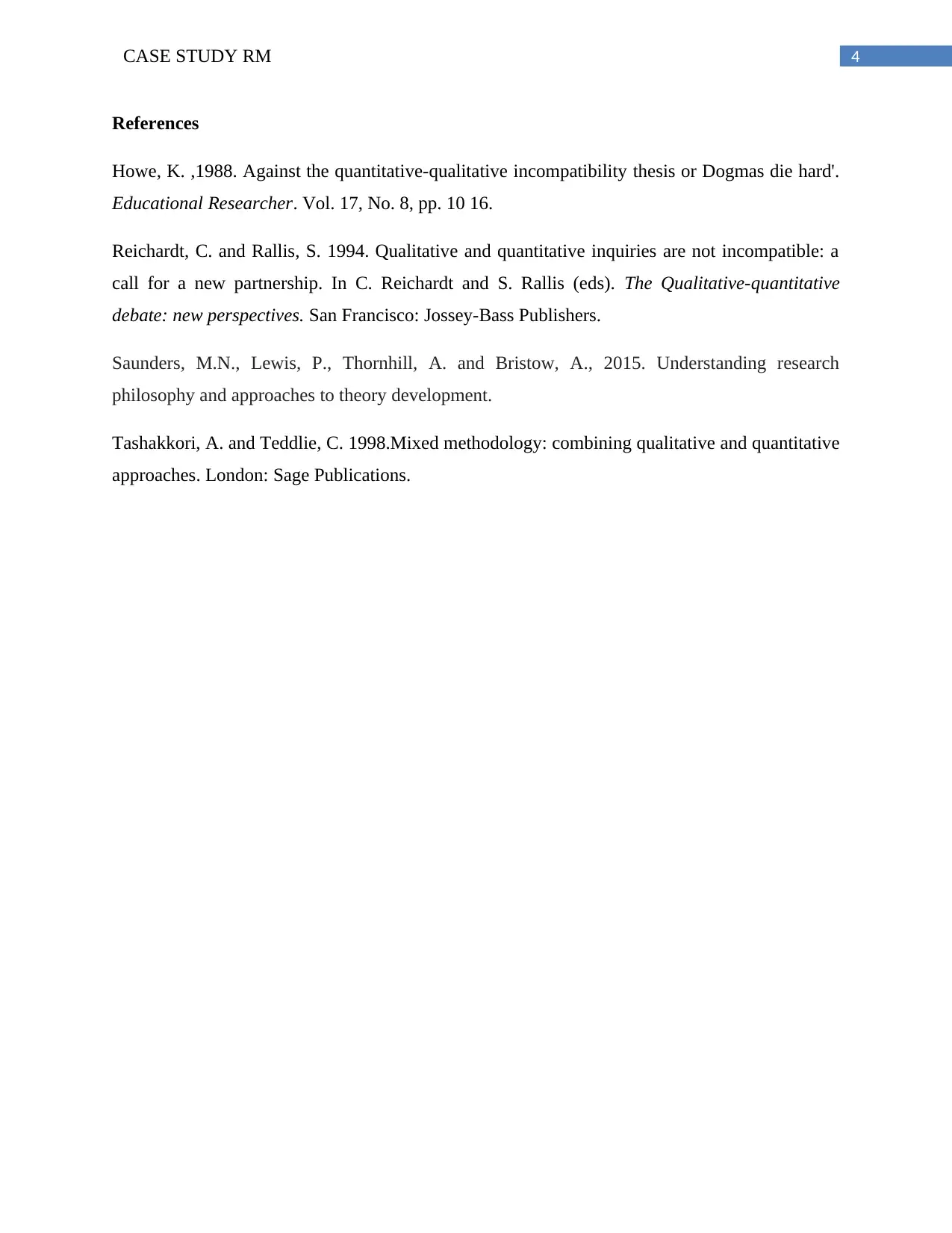Research Methodology Case Study: Analysis and Discussion
VerifiedAdded on 2022/09/07
|5
|1012
|36
Case Study
AI Summary
This case study examines research methodology, focusing on the application of different research philosophies and approaches. It analyzes a scenario involving a consultancy advising a non-profit organization, the Association for Voluntary Organisations for the Elderly (AVOE). The case study explores the challenges of choosing appropriate research methods, particularly the debate between qualitative and quantitative approaches. It delves into the concepts of pragmatism, post-positivism, and interpretivism, highlighting their differences and the importance of selecting the most suitable research design. The case study also discusses the significance of research quality, the role of the researcher, and the need for a mixed-methods approach to address complex research questions effectively. The analysis emphasizes the importance of a sound research design, appropriate sampling techniques, and transparency in the research process.

Running head: CASE STUDY RM
CASE STUDY RM
Name of the Student
Name of the University
Author Note
CASE STUDY RM
Name of the Student
Name of the University
Author Note
Paraphrase This Document
Need a fresh take? Get an instant paraphrase of this document with our AI Paraphraser

1CASE STUDY RM
Answer to Question 1
The Pragmatism can be defined as a research method designed in the 19th century and
aims to ensure that a researcher as involved in a research would be required to promote and
discard the different ideas as well as the hypothesis on the basis of the fact that, their usage and
the suitability is understood or not Moreover, the aspect also believes that the higher mysteries
need to be considered unattainable for better research outcomes.
The post positivist research philosophy can be considered to be a critique of the
positivism. The positivism as a philosophy focuses on the knowledge as processed by the author
and claims that this knowledge can be attained though sensory experiences only and thereby
interpret with the help of logic and reason (Tashakkori and Teddlie 1998). However, the post
positivism differs from this and states that the issues cannot be undertaken based on the
positivist`s habit of treating the researcher`s habit and a completed research has to be undertaken.
The post positivism states that the researcher has a key role to play and that he needs to be
thoroughly involved in the research procedure cycle. The post positivist also stated that there
might take place differences in the researched work which might be depending on the
perspective of the researcher.
Another philosophy is the Interpretivist philosophy which suggests that it is different
from post positivism for expanding on to the theory of positivism itself whereas interpretivist
tends to reject the conclusions of positivism theory wholly and states that the assumptions fact
that the sensory experiences is the most trustworthy form of evidence is incorrect and cannot be
used as an assumption as the ultimate results may turn out to be incorrect in nature (Saunders et
al. 2015). Hence, in conclusion to this, it can be stated that the pragmatism post positivism and
interpretivist share a number of beliefs and comprise of various differences as well. Additionally,
it depends on the researcher to find the best design and philosophy depending on the research
context.
Answer to Question 2
Answer to Question 1
The Pragmatism can be defined as a research method designed in the 19th century and
aims to ensure that a researcher as involved in a research would be required to promote and
discard the different ideas as well as the hypothesis on the basis of the fact that, their usage and
the suitability is understood or not Moreover, the aspect also believes that the higher mysteries
need to be considered unattainable for better research outcomes.
The post positivist research philosophy can be considered to be a critique of the
positivism. The positivism as a philosophy focuses on the knowledge as processed by the author
and claims that this knowledge can be attained though sensory experiences only and thereby
interpret with the help of logic and reason (Tashakkori and Teddlie 1998). However, the post
positivism differs from this and states that the issues cannot be undertaken based on the
positivist`s habit of treating the researcher`s habit and a completed research has to be undertaken.
The post positivism states that the researcher has a key role to play and that he needs to be
thoroughly involved in the research procedure cycle. The post positivist also stated that there
might take place differences in the researched work which might be depending on the
perspective of the researcher.
Another philosophy is the Interpretivist philosophy which suggests that it is different
from post positivism for expanding on to the theory of positivism itself whereas interpretivist
tends to reject the conclusions of positivism theory wholly and states that the assumptions fact
that the sensory experiences is the most trustworthy form of evidence is incorrect and cannot be
used as an assumption as the ultimate results may turn out to be incorrect in nature (Saunders et
al. 2015). Hence, in conclusion to this, it can be stated that the pragmatism post positivism and
interpretivist share a number of beliefs and comprise of various differences as well. Additionally,
it depends on the researcher to find the best design and philosophy depending on the research
context.
Answer to Question 2

2CASE STUDY RM
Jennifer is a Qualitative researcher and a supporter of the qualitative method of research
and analysis. Hence, in case Thomas receives a notice stating that he should be using a pure
qualitative research, Thomas needs to undertake two steps.
In the first step, Thomas needs to write down the arguments against this proposition.
Although the pure qualitative research method will be useful in understanding the reasons why
the various organizations are supporting or are against the AVOE, however, it will not be useful
for the enterprise as the suggestions are not what the firm is looking out for. The firm at present
is at a stage whereby it requires serious results. By undertaking the qualitative method would
give a descriptive approach to the study whereby the different reasons for the involvement may
be found out well (Howe 1988). However, the percentage of population cannot be found in
support of this. As the interview questionnaire will be taken from 80 members, it will help the
managers at the organization to understand the specific number of people for or against a specific
ideology or not. Hence, Thomas can explain this to Jennifer.
Another initiative which Thomas can undertake is to add certain secondary research
questions in addition to the current question. If additional questions supporting the quantitative
research approach can be added, it shall help in carrying out a mixed approach collectively. This
shall assist in finding recommendations in a better manner.
Answer to Question 3
According to Reichardt and Rallis (1994), the quality of the research is not necessarily
determined by the underlying research philosophy. There is no guarantee that the interpretivist is
better than the other approaches which follow pragmatism or post positivism approaches. The
quality in a research may be attained by various aspects coming together for the research
purpose. Hence, it is the duty of a good researcher to undertake the identification of a sound
research design which is appropriate for the question and the objectives which have been set out
for the study. Additionally, the research design also needs to make use of suitable sampling
techniques which enables better and authentic results. Moreover, the research design needs to be
explicit in nature with consideration to the assumptions of the study and present an entirely
transparent research process to the readers in terms of the data collection and the analysis
(Saunders et al. 2015). Hence, in the case of Thomas`s project it can be stated that, the research
Jennifer is a Qualitative researcher and a supporter of the qualitative method of research
and analysis. Hence, in case Thomas receives a notice stating that he should be using a pure
qualitative research, Thomas needs to undertake two steps.
In the first step, Thomas needs to write down the arguments against this proposition.
Although the pure qualitative research method will be useful in understanding the reasons why
the various organizations are supporting or are against the AVOE, however, it will not be useful
for the enterprise as the suggestions are not what the firm is looking out for. The firm at present
is at a stage whereby it requires serious results. By undertaking the qualitative method would
give a descriptive approach to the study whereby the different reasons for the involvement may
be found out well (Howe 1988). However, the percentage of population cannot be found in
support of this. As the interview questionnaire will be taken from 80 members, it will help the
managers at the organization to understand the specific number of people for or against a specific
ideology or not. Hence, Thomas can explain this to Jennifer.
Another initiative which Thomas can undertake is to add certain secondary research
questions in addition to the current question. If additional questions supporting the quantitative
research approach can be added, it shall help in carrying out a mixed approach collectively. This
shall assist in finding recommendations in a better manner.
Answer to Question 3
According to Reichardt and Rallis (1994), the quality of the research is not necessarily
determined by the underlying research philosophy. There is no guarantee that the interpretivist is
better than the other approaches which follow pragmatism or post positivism approaches. The
quality in a research may be attained by various aspects coming together for the research
purpose. Hence, it is the duty of a good researcher to undertake the identification of a sound
research design which is appropriate for the question and the objectives which have been set out
for the study. Additionally, the research design also needs to make use of suitable sampling
techniques which enables better and authentic results. Moreover, the research design needs to be
explicit in nature with consideration to the assumptions of the study and present an entirely
transparent research process to the readers in terms of the data collection and the analysis
(Saunders et al. 2015). Hence, in the case of Thomas`s project it can be stated that, the research
⊘ This is a preview!⊘
Do you want full access?
Subscribe today to unlock all pages.

Trusted by 1+ million students worldwide

3CASE STUDY RM
question indicates a need for a mixed model design, the researcher procedure needs to be
undertaken with integrity and skill and should be based on the knowledge of each research
technique.
question indicates a need for a mixed model design, the researcher procedure needs to be
undertaken with integrity and skill and should be based on the knowledge of each research
technique.
Paraphrase This Document
Need a fresh take? Get an instant paraphrase of this document with our AI Paraphraser

4CASE STUDY RM
References
Howe, K. ,1988. Against the quantitative-qualitative incompatibility thesis or Dogmas die hard'.
Educational Researcher. Vol. 17, No. 8, pp. 10 16.
Reichardt, C. and Rallis, S. 1994. Qualitative and quantitative inquiries are not incompatible: a
call for a new partnership. In C. Reichardt and S. Rallis (eds). The Qualitative-quantitative
debate: new perspectives. San Francisco: Jossey-Bass Publishers.
Saunders, M.N., Lewis, P., Thornhill, A. and Bristow, A., 2015. Understanding research
philosophy and approaches to theory development.
Tashakkori, A. and Teddlie, C. 1998.Mixed methodology: combining qualitative and quantitative
approaches. London: Sage Publications.
References
Howe, K. ,1988. Against the quantitative-qualitative incompatibility thesis or Dogmas die hard'.
Educational Researcher. Vol. 17, No. 8, pp. 10 16.
Reichardt, C. and Rallis, S. 1994. Qualitative and quantitative inquiries are not incompatible: a
call for a new partnership. In C. Reichardt and S. Rallis (eds). The Qualitative-quantitative
debate: new perspectives. San Francisco: Jossey-Bass Publishers.
Saunders, M.N., Lewis, P., Thornhill, A. and Bristow, A., 2015. Understanding research
philosophy and approaches to theory development.
Tashakkori, A. and Teddlie, C. 1998.Mixed methodology: combining qualitative and quantitative
approaches. London: Sage Publications.
1 out of 5
Related Documents
Your All-in-One AI-Powered Toolkit for Academic Success.
+13062052269
info@desklib.com
Available 24*7 on WhatsApp / Email
![[object Object]](/_next/static/media/star-bottom.7253800d.svg)
Unlock your academic potential
Copyright © 2020–2025 A2Z Services. All Rights Reserved. Developed and managed by ZUCOL.




